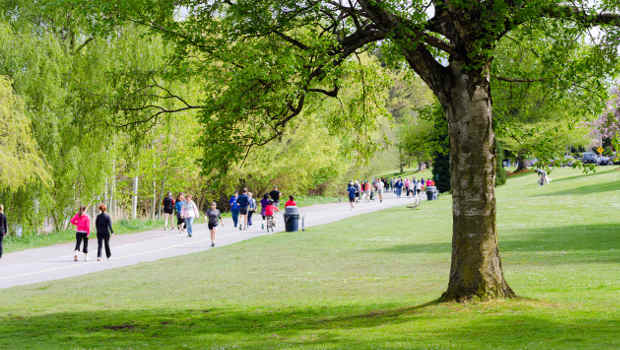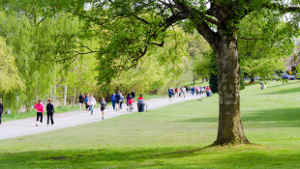How can your neighborhood nudge you toward healthier behavior?

Green Lake park, Seattle.
Dr. Arterburn and UW/KPWHRI team go hyperlocal with $2.67-million Moving to Health award from NIDDK on ‘built environment’
Where people live may matter to their health, weight, and well-being. For instance, some neighborhoods in King County, which includes Seattle, have lots of obesity and type 2 diabetes. Meanwhile, in other communities—some just a mile or two away—people are healthier.
What accounts for these differences?
The Moving to Health project is taking a hyperlocal approach to pinpoint what matters most about individual neighborhoods for their residents’ health. The National Institute of Diabetes and Digestive and Kidney Diseases (NIDDK) recently funded the project for $2.67 million over 5 years.
Designing for the future: Healthier, more livable communities.
“Moving to Health gives us a unique chance to learn which specific characteristics of different neighborhoods are most effective at encouraging people to walk, bicycle, and eat healthy,” says co-principal investigator David Arterburn, MD, MPH, a senior investigator at Kaiser Permanente Washington Health Research Institute (KPWHRI).
Moving to Health from Kaiser Permanente Washington Health Research Institute on Vimeo.
“For years, we’ve been finding links between health and ZIP Codes or Census Tracts,” says co-principal investigator Adam Drewnowski, PhD, a professor of epidemiology, the director of the Center for Public Health Nutrition at the University of Washington (UW) School of Public Health, and director of the multidisciplinary UW Center for Obesity Research. “For instance, in one recent study of King County residents we found a link between healthier eating scores and higher residential property values (an objective measure of wealth), education, and incomes.”
But you needn’t get rich to be healthier
“Your family might move to a neighborhood with home values similar to your previous neighborhood’s—yet with added amenities that could help your family become healthier,” says study co-investigator Anne Vernez Moudon, Dr es Sc, a UW professor emeritus of urban design and planning at the UW College of Built Environments.
For instance, your new neighborhood might have features that encourage you to go out and walk or bike more—sidewalks, streetlights, bike lanes, parks, walking paths, buses, light rail, a library, or a community center. A nearby supermarket, farmer’s market, or pea patch may provide access to healthy food—as opposed to just a convenience store.
“Those of us who study the 'built environment' have learned about what encourages people to walk and bicycle more,” Dr. Vernez Moudon adds. The built environment means the human-made places where people live, work, and play—from buildings to parks.
“This study gives us a chance to see which of those things actually make the biggest difference for health,” says co-investigator Dori Rosenberg, PhD, MPH, an assistant investigator at KPWHRI. “What’s working in some communities that could be spread to help everyone be healthier and safer?”
Move to a new home? Or not?
Moving to Health takes advantage of the “natural experiment” of people moving their residence—or staying put. Keeping private all information that could identify anyone, the study is using “big data” from about 400,000 Kaiser Permanente members in King County over the past 12 years. More than 1 in 3 of these adults and children have moved their residence during that time.

Of those who’ve moved, around half now live in neighborhoods with average incomes like those where they used to reside; 1 in 4 are in communities with higher average incomes than their old neighbors; and another 1 in 4 are in lower-income ones.
“We’ll see how moving from one kind of neighborhood to another affects people’s long-term weight and blood sugar—and whether they develop diabetes,” Dr. Arterburn says. “For people who don’t move, we’ll also see whether more gradual changes in communities are linked to trends in weight and blood sugar.”
“Diabetes raises the level of sugar in the blood,” explains co-investigator Paula Lozano, MD, MPH, a senior investigator at KPWHRI. “Heavier people are at higher risk for type 2 diabetes, which used to be called adult-onset diabetes. But with the obesity epidemic even affecting children, type 2 diabetes is starting to cause problems at earlier ages. If we can learn how to make neighborhoods healthier, we may be able to help reverse this trend.”
What’s new and different?
“For Moving to Health, we’re going hyperlocal, zooming in closer than ZIP Codes or Census Tracts,” Dr. Arterburn says. “We can look carefully at the neighborhood surrounding each building.” Also unlike many prior studies, this one is longitudinal, tracking people and changes to their neighborhoods over time instead of taking a single cross-sectional snapshot.
“Our team is lucky to have two biostatistician co-investigators,” Dr. Arterburn says. Andrea Cook, PhD, a KPWHRI senior investigator, and Jennifer Bobb, PhD, a KPWHRI assistant investigator, are developing novel methods to analyze the many dimensions of changing people moving in evolving spaces over time, including understanding how these things may cluster together.
“What we discover about how certain neighborhood factors influence weight and blood sugar may help urban planners create healthier communities,” Dr. Drewnowski says. “And it may help people decide where to live.” They could take an area’s health-promoting surroundings into consideration, along with housing price, schools, and convenience to their workplace.
“We know that factors in people’s communities can influence their health as much or even more than medical care does,” Dr. Arterburn says. “And from the experience with tobacco we know that public policy changes can nudge us strongly toward healthier behavior. That’s why I’m so excited that with Moving to Health we’ll look beyond our clinics’ walls and into our communities—and possibly influence policy.”
Moving to Health is supported by grant R01DK11419 from the NIDDK of the National Institutes of Health.
by Rebecca Hughes
Co-researchers
Paula Lozano, MD, MPH
Senior Investigator; Director, ACT Center
Kaiser Permanente Washington Health Research Institute
Dori E. Rosenberg, PhD, MPH
Senior Investigator
Kaiser Permanente Washington Health Research Institute
Andrea J. Cook, PhD
Senior Biostatistics Investigator
Kaiser Permanente Washington Health Research Institute
Jennifer F. Bobb, PhD
Associate Biostatistics Investigator
Kaiser Permanente Washington Health Research Institute
KPWHRI News

October 2017
- How can your neighborhood nudge you toward healthier behavior?
- SOS colon cancer screening program shows 5-year success
- Can kids be screened routinely for adverse childhood experiences?
- A core competency for health system researchers—striking a balance
- Helping teens — and their families — manage online health care
- Suicide risk: As predictable as getting struck by lightning?
- Flu shots boost your chances of staying well


